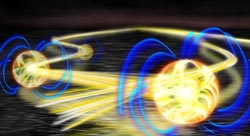Key Processes of Photosynthesis Simulated on the Quantum Level

Dipole-mediated energy transport of Rydberg-excitations (glowing balls) in an atomic sea – artist impression<br><br>Picture credits: S. Whitlock / G. Günter<br>
By realising an artificial quantum system, physicists at Heidelberg University have simulated key processes of photosynthesis on a quantum level with high spatial and temporal resolution. In their experiment with Rydberg atoms the team of Prof. Dr. Matthias Weidemüller and Dr. Shannon Whitlock discovered new properties of energy transport.
This work is an important step towards answering the question of how quantum physics can contribute to the efficiency of energy conversion in synthetic systems, for example in photovoltaics. The new discoveries, which were made at the Center for Quantum Dynamics and the Institute for Physics of Heidelberg University, have now been published in the journal “Science”.
In their research, Prof. Weidemüller and his team begin with the question of how the energy of light can be efficiently collected and converted elsewhere into a different form, e.g. into chemical or electric energy. Nature has found an especially efficient way to accomplish this in photosynthesis. Light energy is initially absorbed in light-harvesting complexes – an array of membrane proteins – and then transported to a molecular reaction centre by means of structures called nanoantennae; in the reaction centre the light is subsequently transformed into chemical energy. “This process is nearly 100 per cent efficient. Despite intensive research we’re still at a loss to understand which mechanisms are responsible for this surprisingly high efficiency,” says Prof. Weidemüller. Based on the latest research, scientists assume that quantum effects like entanglement, where spatially separated objects influence one another, play an important role.
In their experiments the researchers used a gas of atoms that was cooled down to a temperature near absolute zero. Some of the atoms were excited with laser light to high electric states. The excited electron of these “atomic giants”, which are called Rydberg atoms, is separated by macroscopic distances of almost a hair’s breadth from the atomic nucleus. Therefore these atoms present an ideal system to study phenomena at the transition between the macroscopic, classical world and the microscopic quantum realm. Similar to the light-harvesting complexes of photosynthesis, energy is transported from Rydberg atom to Rydberg atom, with each atom transmitting its energy packages to surrounding atoms, similar to a radio transmitter.
“To be able to observe the energy transport we first had to find a way to image the Rydberg atoms. At the time it was impossible to detect these atoms using a microscope,” explains Georg Günter, a doctoral student in Prof. Weidemüller’s team. A trick from quantum optics ensured that up to 50 atoms within a characteristic radius around a Rydberg atom were able to absorb laser light. In this way each Rydberg atom creates a tiny shadow in the microscope image, allowing the scientists to measure the positions of the Rydberg atoms.
The fact that this technique would also facilitate the observation of energy transport came as a surprise, as PhD student Hanna Schempp emphasises. However, the investigations with the “atomic giants” showed how the Rydberg excitations, which are immersed in a sea of atoms, diffused from their original positions to their atomic neighbours, similar to the spreading of ink in water. Aided by a mathematical model the team of Prof. Weidemüller showed that the atomic sea crucially influences the energy transport from Rydberg atom to Rydberg atom.
“Now we are in a good position to control the quantum system and to study the transition from diffusive transport to coherent quantum transport. In this special form of energy transport the energy is not localised to one atom but is distributed over many atoms at the same time,” explains Prof. Weidemüller. As with the light-harvesting complexes of photosynthesis, one central question will be how the environment of the nanoantennae influences the efficiency of energy transport and whether this efficiency can be enhanced by exploiting quantum effects. “In this way we hope to gain new insights into how the transformation of energy can be optimised in other synthetic systems as well, like those used in photovoltaics,” the Heidelberg physicist points out.
Online information:
Research group of Prof. Weidemüller: http://www.physi.uni-heidelberg.de/Forschung/QD
Center for Quantum Dynamics: http://cqd.uni-hd.de
Institute for Physics: http://www.physi.uni-heidelberg.de/?lang=en
Original publication:
G. Günter, H. Schempp, M. Robert-de-Saint-Vincent, V. Gavryusev, S. Helmrich, C.S. Hofmann, S. Whitlock, M. Weidemüller: Observing the Dynamics of Dipole-Mediated Energy Transport by Interaction Enhanced Imaging, Science Express (7 November 2013), doi: 10.1126/science.1244843
Contact:
Prof. Dr. Matthias Weidemüller
Institute for Physics / Center for Quantum Dynamics
Phone +49 6221 54-19471, -19470 (secretary’s office)
weidemueller@uni-heidelberg.de
Communications and Marketing
Press Office, phone: +49 6221 54-2311
presse@rektorat.uni-heidelberg.de
Media Contact
More Information:
http://www.uni-heidelberg.deAll latest news from the category: Physics and Astronomy
This area deals with the fundamental laws and building blocks of nature and how they interact, the properties and the behavior of matter, and research into space and time and their structures.
innovations-report provides in-depth reports and articles on subjects such as astrophysics, laser technologies, nuclear, quantum, particle and solid-state physics, nanotechnologies, planetary research and findings (Mars, Venus) and developments related to the Hubble Telescope.
Newest articles

Innovative 3D printed scaffolds offer new hope for bone healing
Researchers at the Institute for Bioengineering of Catalonia have developed novel 3D printed PLA-CaP scaffolds that promote blood vessel formation, ensuring better healing and regeneration of bone tissue. Bone is…

The surprising role of gut infection in Alzheimer’s disease
ASU- and Banner Alzheimer’s Institute-led study implicates link between a common virus and the disease, which travels from the gut to the brain and may be a target for antiviral…

Molecular gardening: New enzymes discovered for protein modification pruning
How deubiquitinases USP53 and USP54 cleave long polyubiquitin chains and how the former is linked to liver disease in children. Deubiquitinases (DUBs) are enzymes used by cells to trim protein…


